#south indian rice recipes
Explore tagged Tumblr posts
Text
Raw Mango Rice (Mavinakayi Chitranna, Mamidikaya Pulihora)
Raw Mango Rice (Mavinakayi Chitranna, Mamidikaya Pulihora) is a South Indian Raw mango-flavored rice. This is a variation of the popular lemon rice, with a tang from green mangoes. It is called Mavinakayi Chitranna, Mamidikaya Pulihora, or Mangai Sadam in different South Indian languages. Raw Mango Rice is a simple South Indian Rice preparation where cooked rice is sauteed along with grated…

View On WordPress
#Easy Raw Mango Rice#Green Mango Rice#healthy recipes#How to Make Raw Mango Rice#Indian Raw Mango Rice#Mamidikaya Pulihora#Mango recipes#mango rice#Mango Rice Ingredients#Mango Rice South Indian Style#Mavinakayi Chitranna#no onion garlic rice recipe#Raw Mango Pulihora#raw mango recipes#raw mango rice#Raw Mango Rice Preparation#Raw Mango Rice Recipe#Regional Indian Cuisine#Rice Recipes#South Indian Mango Rice#south indian rice recipes#spicy veg recipes
0 notes
Text
Lemon Rice And More: 7 Quick Rice Recipes Ready Under 30 Minutes
Whenever we’re unsure about what to cook dinner, rice is one meals that at all times pops into our minds. The humble grain isn’t just straightforward to organize but in addition extraordinarily versatile. You can have it with dal, get pleasure from it with flavours like tomato or tamarind, and even make pulao or biryani with it. Rice can be extraordinarily fast to make as you’ll be able to put…

View On WordPress
#easy rice recipes#imli rice#lemon rice#rice recipe#rice recipe video#rice recipes#rice recipes in under 30 minutes#rice recipes south indian#tomato rice#tomato rice recipe
2 notes
·
View notes
Text
How to make ven Pongal | Ghee Pongal |South Indian Breakfast
Ven Pongal Ven Pongal is a beloved South Indian comfort food known for its creamy and savory goodness. This dish is a warm and hearty porridge made from a harmonious blend of rice and lentils, traditionally seasoned with black peppercorns and cumin seeds. The rice and lentils are cooked to a rich, creamy consistency, creating a comforting texture that’s both soothing and satisfying.Ven Pongal…
#ghee pongal#how to make easy instant one pot ven pongal#how to make proper ven pongal recipe#origin of ven pongal#pongal#pongal making#pongal recipe#rice and lentil porridge#south indian breakfast#ven pongal#ven pongal instant pot recipe#ven pongal recipe#ven pongal recipe instant pot#water ratio for pongal#what is the correct amount of water in ven pongal#what is ven pongal
0 notes
Text
Plantain Fry Recipe
Crispy Plantain Fry (Vazhakai Fry) Recipe – A Simple and Delicious Side Dish. Plantain fry, also known as Vazhakai Fry in South Indian kitchens, is a quick and easy side dish that adds a crispy and flavorful touch to any meal. Made with green plantains and minimal ingredients, this recipe is perfect for pairing with rice dishes like sambar, rasam, or curd rice. Here’s how you can make this simple…
#crispy plantain fry#easy plantain fry#Indian plantain recipe#plantain fry#plantain fry for rice#plantain side dish#plantain slices fry#raw banana fry#raw banana side dish#shallow fried plantain#simple vazhakai fry#South Indian plantain recipe#spicy plantain fry#turmeric plantain fry#vazhakai fry#vazhakkai recipe#vegan plantain recipe
0 notes
Text
Lemon Rice: A Tangy Delight to Brighten Your Day!
Lemon Rice: A zesty, aromatic South Indian staple for any occasion.
Has life been giving you Lemons? Well squeeze that juice and make Lemon Rice! Why make lemonade when you can rice up in life? This true South Indian staple dish is like a little party in your mouth, combining the nutty aroma of tempered spices with the refreshing tang of zesty lemon juice. Whether you’re a seasoned cook or a kitchen newbie, this recipe is a must-try. Nutrition…

View On WordPress
#Chitranna#Easy vegetarian#Flavorful rice#Lemon Rice#panvel#South Indian recipe#Tangy rice#thepanvelite
0 notes
Text
youtube
Delicious Chennai Dum Biryani Recipe
Watch and learn how to make an authentic Chennai Dum Biryani with tender chicken and fragrant basmati rice. This step-by-step tutorial will guide you through the process, so you can enjoy this mouthwatering South Indian delicacy at home. Don't miss out on this flavorful biryani preparation!

#BiryaniRecipe#ChennaiDumBiryani#IndianCuisine#CookingTutorial#FoodieDelights#Chennai Dum Biryani#Chicken Biryani#Basmati Rice#Indian Cooking#South Indian#Biryani Recipe#Cooking Tutorial#Homemade Biryani#Flavorful#Delicious#Food Preparation#Step-by-Step#Foodie#South Indian Cuisine#Spices#Food Inspiration#Food Vlog#Culinary Skills#Indian Spices#Aromatic Biryani#Youtube
0 notes
Photo

Authentic and Easy Shrimp Curry This is a home-style South Indian shrimp curry recipe from my husband's family. It is simple and quick to make. It contains no coconut so is not sweet, just mostly juicy and as hot as you like it. Serve with basmati rice or an Indian flatbread.
0 notes
Text
“Sambar Recipe: Step-by-Step Guide to Make Delicious South Indian Sambar at Home”
Sambar is a popular and traditional South Indian dish that is typically made with lentils, vegetables, tamarind, and a unique blend of spices. read more.
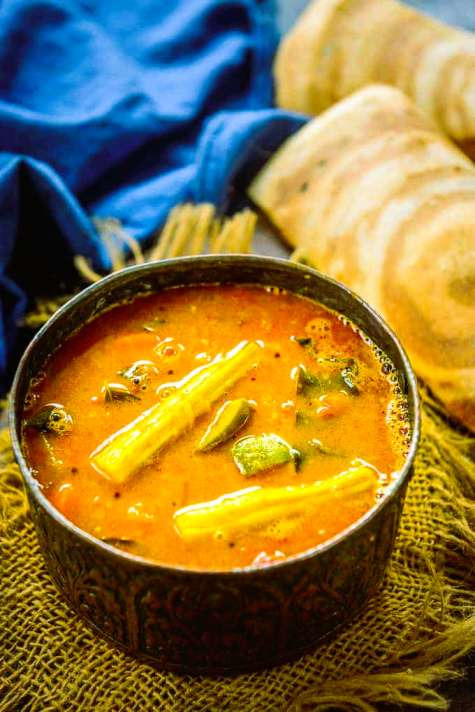
#sambar#sambar podi#idly sambar#sambar in tamil#tiffin sambar#sambar rice recipe#sambar for rice#kalyana veetu sambar#vegetable sambar#sambar recipe in tamil#sambar tamilnadu style#murungakkai sambar#rice sambar recipe#hotel style sambar#traditional sambar#how to make sambar#south indian sambar#hotel sambar recipe#village style sambar#vengaya sambar recipe#sambar recipe for begginers#saravana bhavan style sambar#asmr cooking
0 notes
Link
1 note
·
View note
Text
THE FOODIES & GOODIES EVENT MASTERLIST — JUJUTSU KAISEN

Bento Box Blunder (by @pmpmyread) Pairing/Characters: Kento Nanami x f!Reader Tags/cw: None, barring the gratuitous mentions of food. Summary: You’d always admired Kento Nanami from a distance, even harbouring a small crush on him, sentiments you’d only allowed yourself to indulge within the safe sanctuary of your discretion. Then one day, you stole his lunch.
-
Tuna Mayo (by @redlikerozez) Pairing/characters: Inumaki Toge x gn!Reader Tags/cw: Canon typical descriptions of violence, dealing with loss of limb, probably inaccurate description of making rice balls. Summary: Inumaki Toge tries to make rice balls in the aftermath of Shibuya. Reader helps him out. Or an Inumaki Toge-centric fic about dealing with the events of Shibuya while also being absolutely whipped for GN!Reader.
-
Get that bread, Sir (by @rahuratna) Characters: Nanami Kento. Ijichi Kiyotaka. Tags/cw: fluff, comedy. Summary: One assistant. One sandwich. One ruthless adversary in the quest for quality bread.
-
Love you a latte (by @kentocalls) Pairing/characters: Fushiguro Toji x f!Reader Tags/cw: Fluff. Summary: Lazy mornings with Toji and a passion for coffee.
-
Lollipop kiss (by @tsukimefuku) Pairing/characters: Kusakabe Atsuya x gn!Reader Tags/cw: comedy, fluff, this man is completely clueless but reader isn’t making things any easier. making out and happy ending. there is a bartender very invested in the drama. a little suggestive if you squint. Summary: your workplace crush, kusakabe, is pretty dense when it comes to romance, so you try to ease things out with a bag of lollipops.
-
My Cinnamon Girl (by @actuallysaiyan) Pairing/characters: Nanami Kento x f!Reader Tags/cw: smoking, general fluff Summary: Kento is your regular customer and one night when he really needs you, he ends up finding you outside smoking and you offer him some pastries.
-
Love you a waffle lot, you know? (by @senseifupa) Pairing/characters: Higuruma Hiromi x f!Reader Tags/cw: sfw with smoochin, fluff, established relationship, soft Hiromi. Summary: Hiromi and you share warm moments over waffles.
-
My "Batter" Half (by @seireiteihellbutterfly) Pairing/characters: Nanami x f!Reader Tags/cw: saw, fluff, cuteness. Summary: You decide to make one of your favorite South Indian recipes while accompanied by Nanami.
-
Good Enough to Eat (by @fattybattysblog) Pairing/characters: Mahito x Female Original Character Tags/cw: Smut, inappropriate use of food and cursed techniques, temperature play, Mahito is his own content warning. Summary: "Can't I just visit a friend?" he asked slyly. "We'd have to be friends first," she grumbled. Mahito's laughter echoed through the room, a sound that made Hairi's skin prickle. He sat upright and rested his arm on his knee. "Touché," he said, licking another drip of ice cream. "But, you know, we're not so different. We could be friends." Hairi raised an eyebrow. "Friends don't usually show up unannounced and uninvited." "Isn't spontaneity the spice of life?" he leaned forward, his eyes glinting with mischief. "Besides, I think we both know there's more between us than just animosity." She scoffed, taking a defiant bite of her own cone. "In your dreams." "Actually... in yours," he purred, his gaze lingering on her lips.
-
Egg Fried Rice (by @tiny-wooden-robot-fics) Pairing/characters: Geto Suguru x Original Female Character Tags/cw: Fluff, Mentions of food and alcohol, Flirting, Pre-established friendship, Geto and OC are roommates, There is some suggestiveness near the end, This is part of a series Summary: “I was,” she admits, “but I realized I didn’t feel like working out tonight and decided to make greasy food instead.” She raises an eyebrow, taking his spoon from him and helping herself to his bowl of fried rice. “And anyway, I’m allowed to eat and drink whatever I want, Suguru.” “The point of cooking enough for both of us is so we can each have our own… is it not?” He looks pointedly at the spoon in her hand. “It tastes better when I take it from you,” she laughs. She holds a spoonful of rice up to his mouth. He hesitates only for a moment before letting her feed him. “You’re definitely different,” he chuckles once he’s done chewing. He doesn’t realize he’s said the words aloud until she goes quiet, her brown eyes wide and staring.
#jjk#jujutsu kaisen#nanami kento#jjk nanami#higuruma hiromi#jjk fanfic#nanami x reader#jujutsu nanami#jjk higuruma#kento nanami#jujutsu mahito#jjk mahito#mahito#kusakabe#jjk kusakabe#kusakabe atsuya#geto suguru x oc#geto suguru#suguru geto#toge inumaki#inumaki toge#jjk inumaki#inumaki x reader#hiromi higuruma x reader#mahito x oc#ijichi fluff#ijichi kiyotaka#jjk ijichi#jujutsu kaisen ijichi#fushiguro toji x reader
156 notes
·
View notes
Note
Can we also get a desi reader for Tim, Bruce, and aged up damian, please?
Bruce Wayne x South Asian!Reader
ok i did say whatever you ask is yours...but tbh i'm not much of an anyone-other-than-jason-or-dick girlie (i knowww i'm sorry). maybe in the future i'll write for the others but for now here's some bruce content. hope it's okay pleeease don't hate me. also sorry this took literally 50 years i was going thru some stuff💀
batboys x south asian!reader masterlist
I think he’d try really hard to impress you by taking you to those super fancy Michelin star Indian fusion restaurants. They’re good but don’t have quite the same charm as home cooked Indian food, so you bring him back to your place and cook for him.
I’m gonna be real here…all that man really needs is a kiss and one of grandma’s recipes. You feed him a bite straight from the pot and the softness and intimacy of the action alone almost has him in tears, never mind the love and warmth of a home cooked meal
You two come back to your place late one night after an event and you’re craving some comfort food, so you heat up some leftover rice with ghee and jaggery, and he doesn’t seem to have much of a reaction when he tries it, but when you guys have a fight that results in you not seeing each other for a few days, when you finally return to the manor Alfred informs you that was the only thing he ate because it reminds him of you and he missed you😭
I imagine not being very used to how much money he has, so some of the wealthy stuff he does is kinda weird to you. Seriously, this man has been a billionaire his entire life, so you can’t tell me that at least a morsel of Brucie Wayne’s financial out-of-touchness isn’t a tiny bit real
You tell him that in your culture, it’s common to gift gold at really special milestones/occasions. But he gets carried away.
He buys you a bunch of gold jewelry, like for every occasion and it’s like…real, solid, 22k gold. You try to tell him that it’s too much and you don’t need anymore and please stop buying it but he’s just like “why🤨🤨? That gold necklace was only a thousand dollars that’s so cheap” and you make him stand in the corner
I think he’d feel so weird about not wearing shoes at your place but you make him get used to it🤷♀️
He’s a genius fr so he picks up your language very easily
You love the super extra Uber-dramatic soap operas and it’s a guilty pleasure of yours to watch them before bed. I can just imagine the two of you huddled together in bed watching them on your laptop. He makes sure all the TVs in the house have all the channels you like. Eventually he can’t sleep without watching them either😭
I think he’d love certain perfume scents that are from South Asia, and he’d buy you fancy those perfume oils
I’m sorry but…I can NOT see this man wearing a kurta. Like I just don’t think he’d do it.
Lighting incense in the batcave. That’s all
incorporating this ask bc it's relevant:

One day you’re making chai, and you ask him to bring the pot from the stove to the counter for you. That thing^ is lying next to the stove, but he doesn't know what that is. And since he can withstand intense levels of pain without flinching he just. Picks up the boiling pot with his bare hands and brings it to you.
"Why didn't you use the clamp?!" "How was I supposed to know what that thing was!!" You show him how to use it but he's kinda petty ("Why can't you just use a normal pot with a normal handle?! Why are you making more work for yourself?") so he refuses to use it and just keeps handling the pot with his bare hands.
But one day you're deep in conversation while making chai. The pot is boiling and he handles it anyway, but you're distracted and you forget that he can do that. You assume it's not hot so you touch it and burn yourself and he feels sooo bad. He's kissing all over your hands and pampering you for the whole day. He finally gives in and just starts using the stupid clamp.
I hc Bruce as being a consistent meditator. He probably spent a lot of time learning about it while training across the world and it helps him feel grounded and calm. He tries to get his kids to do it too, but they don't all like it as much as him. So if you meditate with him every now and then he really appreciates that.
You try to get him into yoga along with it and he's like...scarily good at it. He's not super flexible like Dick, so he chooses to opt out of the super bendy poses, but his core strength is unmatched. He can balance his entire bodyweight on one limb no sweat. He's not wobbling, shaking, or tipping over. He's still as a statue and he can last for hours. (😏)
If you get married, I don’t think it would be a huge event. Like there would probably be some kind of reception that’s more of a formality/business event than anything else where he puts on Brucie Wayne, but for the actual ceremony I think it would just be the family
He'd fly you to your home country to have the ceremony there at some super fancy historical attraction. Even if it's just you and some other close people, he's getting the whole place shut down for the day just for you.
I can’t imagine needing to step into a stepmom role for anyone? Except maybe Cass, Duke, and Damian when his mom isn’t around. The four of you DEFINITELY gang up on Bruce all the time and make fun of his whiteness.
You’d also totally gift them traditional wear
The first time you make dinner for everyone, you make it spicy and everyone loves it, but Bruce is just sitting there SWEATING
He’s so good at keeping a poker face that you wouldn’t have even been able to tell it was too spicy for him if not for the beads of sweat on his face. You give him milk to help soothe the heat but he never lives it down
But you actually are so mothering to the kids, you make them turmeric milk when they’re sick and chai with biscuits when they come home from school🫶and it's so sweet it makes Bruce fall for you all over again
When you move in the whole wearing shoes in the house still bothers you, but you can’t stop everyone else from doing it, so you declare your bedroom a no shoes zone. Bruce can wear shoes anywhere else in the house but NOT your bedroom.
And if you still feel weird about wearing shoes around the manor, he'll buy you a bunch of pairs of home slippers and stash them all over the place
Whenever you stay over he brings you chai in the morning. Once you're married and living with him, he brings it to you in bed every morning. At one point he's like "You know Alfred can bring it for both of us" but you insist it tastes so much better when it's from him, and he can't say no to you.
me personally i like to support women's organizations in south asia, i.e. access to education and better healthcare which means things like menstrual products & obgyn care so i am going to hc that after you share how passionate you are about those, WE partners with an existing charity for those issues, both in south asia and other parts of the world and raises tons of money to donate...take that if you like it (world so bad we writing fanfic about equality now😭)
Since he's a famous billionaire playboy he 100% has an internet presence (likely curated to fit Brucie) and there are tons of edits and memes about him. When the world finds out his partner is south asian, brown people probably go a little insane and there's definitely tons of those memes where they photoshop his face over someone in traditional wear and caption it "Bajju Wagle" or some other name with his initials LMAO
#batman#red hood#jason todd#batfamily#dc universe#dc comics#dcu#dc robin#robin#dick grayson#bruce wayne#damian wayne#tim drake#nightwing#red robin#red hood x reader#batfam#robin jason todd#bruce wayne x reader#bruce wayne x y/n#bruce wayne x you#bruce wayne x fem!reader#batman x reader
73 notes
·
View notes
Text
Instant Ragi Dosa Recipe – Healthy & Crispy Finger Millet Dosa
Instant Ragi Dosa Recipe – Healthy & Crispy Finger Millet Dosa Ragi dosa is a nutritious and delicious South Indian dish made with finger millet flour (ragi). This instant version requires no fermentation, making it a quick healthy breakfast or dinner option. Packed with fibre, calcium, and iron, ragi dosa is an excellent choice for a wholesome meal. Let’s dive into the recipe! Why You’ll Love…
#Best millet dosa for weight loss#Crispy Ragi Dosa#Easy dosa recipes#Finger Millet Dosa#Healthy gluten-free dosa recipe#Healthy Ragi Dosa#How to make crispy Ragi Dosa at home#How to make Ragi Dosa#Instant Ragi Dosa#Instant Ragi Dosa recipe without rice flour#Millet dosa recipe#Ragi Dosa batter recipe#Ragi Dosa Recipe#Ragi Dosa with coconut chutney#Ragi Dosa without fermentation#Ragi recipes for weight loss#South Indian breakfast recipes
0 notes
Text
My "Batter" Half

A/N: Written for @tsukimefuku's foodies and goodies challenge. Coming out of a bit of a writing slump with everything going on atm, so I hope this doesn't disappoint.
Pairing: Nanami x Fem! Reader (Desi reader coded)
Rating: E, safe, fluffy, cute
Word Count: 897

Nanami sits on one of the barstools at your kitchen’s island watching you bustle around getting all the grains the recipe called for.
“Sweetie, I only asked if it was possible sometime this week. You don’t have to make it for me right away.”
You shush him, pushing your hair out of the way as you measure the Sona Masoori rice, flat rice, and fenugreek, throwing them all into a large baking bowl and hefting the bowl towards the sink, adding in enough water so that a thin layer covered all of it. You cover the bowl with saran wrap and place it away on the countertop.
There was no question that you loved cooking for Nanami, but something in you glowed when he asked for South Indian food. There was a regular rotation in what the pair of you cooked but when he asked for masala dosa, you melted inside, all of your senses kicking into high gear to feed him what he craved. It was comfort food for you growing up, and it meant the world to you that he had grown to love it too.
He knew the effort it took, an almost 2-day process just to make the batter, so he didn’t normally ask for it. The first step was done, letting the grains ferment overnight in water. You wash your hands and join him at the island.
“It’s no trouble at all Kento. Anything for you.” You rest your head against his shoulder, a soft sigh emanating from him as he puts an arm around you. “Hopefully it’ll be all nice and soft tomorrow. Then I’ll run it through the grinder to make the batter and it’ll have to sit overnight in the oven, so don’t plan on baking anything tomorrow.”
He chuckles, the soft vibrations felt against your hair. “Roger that. But you still didn’t have to get started so immediately.”
“You rarely ask for anything. I couldn’t resist.” You press a kiss to his cheek. “Let’s go to bed.”
── ⋆⋅☆⋅⋆ ──
The next day morning, you check the bowl, pleased to see all the components have fluffed up and taken in as much water as they could. You begin to set up the little grinder that would change the grains into batter, carefully placing the rod mechanism attached to two 5-pound stones into the apparatus. Once in place, you switch it on, and carefully begin adding the grain mixture in between the two stones, adding water to help it along and adjust the thickness. Once all the rice has been put into the contraption, you sit and wait, watching the batter form, checking it for smoothness and ensuring the grain wasn’t clustering into lumps.
You salt the mixture well and then cover it again with saran wrap, then place it inside the oven, where the added humidity would help the batter thicken and rise, making for the fluffiest dosas.
Kento wanders downstairs, ready for work in a crisp shirt and tie, eyes taking in the scene in the kitchen. “Someone was up early today,” he observes as you start disassembling the grinding machine. You give him a pleased smile and carefully set the heavy stones back into the box they belonged in.
“Had to. The earlier I start the process, the quicker it’ll ferment. Who knows, maybe even by tonight if we get lucky.”
Nanami smiles tenderly and pulls you into a hug. “Whenever honey. I’m just glad you took the time to make it.”
You kiss him tenderly before he leaves for work.
── ⋆⋅☆⋅⋆ ──
The day has finally arrived. You check the oven and almost giggle from the delight of seeing the fluffy batter resting in the large bowl. It was ready.
As Nanami slept in, a rare luxury he could only afford on weekends, you begin prepping the dosa filling, throwing the potatoes into a pressure cooker, while chopping onions into half-circles. Once the pressure cooker whistles 3 times, you take it off the flame, waiting for it to cool, before mashing the potatoes. Deftly, you heat the oil in a large wok, tossing in mustard seeds, green chilies, and black lentils for tempering. Once they start to sizzle, you throw a few curry leaves on top, the pleasant crackle bringing a smile to your lips.
The onions and potatoes are tossed into the wok and mixed with a pinch of turmeric, and some cilantro. A fragrant scent fills the kitchen as you set it aside and get ready to make the dosa. A ladle dipped into the fluffy batter, then spread thinly on a greased pan, going in concentric circles from the middle until it starts to heat up and harden, becoming crisp. You scoop some of the onion potato filling and place it in the center, allowing the dosa to harden a little longer before folding it in half and placing it on a plate.
You’re about to start the second one when Nanami wanders into the kitchen, still in his pajamas.
“My nose woke me up,” he says good-naturedly, wrapping his arms around your waist.
You sigh contentedly, laying down the batter for the next one as Nanami breaks off a piece of dosa and tucks into the filling. He chews and swallows, savoring the spice.
“Delicious,” he whispers, and your heart swells with joy, his appreciation the only thing you needed.
Nanami masterlist | JJK Masterlist

Stars divider by @/ saradika. Support banner by @/ cafekitsune
@estarlias @daswanj @whatshernameis @byul9158 @mirrors-musings @Mangiswig
@that-goth-bisexual @connorsui @jadedjane @darkstarlight82 @soft--cherry @galactict3a @hunnie-lily
#foodies and goodies challenge#nanami#nanami kento#nanami kento x reader#nanami x reader#jjk nanami#nanami kento fluff#desi reader#nanami kento x desi reader#desi writers#desi women#nanami kento x indian reader#desi tag#nanami kento x you#nanami kento jjk#nanami kento x y/n#nanami kento fanfic#vee writes
121 notes
·
View notes
Note
do you think the lamb stew kabru mentioned could be some variation of rogan josh?
omg anon I'm so sorry, you sent this message just when my life was going completely insane (tree fell on house, living in a hotel, etc), and I wanted to answer you but I just didn't have time... So I forgot.
And then another anon (or maybe it's still you!) sent me another, similar ask!

Which reminded me that I needed to answer you-- and now them, too!!
Food is not an area of expertise for me, so I had to look up all of these dishes. I'd heard the term "gorkhali" before, and heard of rogan josh, but that's as far as my knowledge went.
Let's talk about what we know about where Kabru comes from and what foods he likes, the food culture of South Asia in the real world, and then we can discuss if any of these dishes might be Kabru's childhood lamb stew!
I've written about the real world cultural references Kui has made with Kabru's character before. Evidence that Kabru is from a fantasy version of South Asia (India/Nepal), and Where exactly in fantasy South Asia is Kabru possibly from?
Two additional data points that suggest Kabru could be from a fantasy version of South Asia are his love of tomatoes, and mutton stew being an important dish from his childhood. What does that mean?
THE CULTURAL OVERLAP BETWEEN INDIA, NEPAL AND TIBET
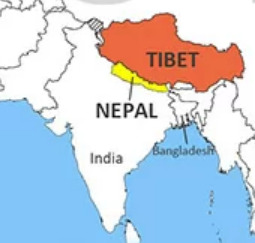
An important thing to note while discussing the cultures of this region is that all three modern countries have a lot of cultural overlap. So many of the foods eaten in one country are also eaten in the other two, with minor variations.
I'm attempting to generalize and speak broadly as best I can, but I am not an expert, so I apologize for any errors on my part. Sometimes finding English-language information on these topics is challenging.
The cuisine of Nepal is a mix of Nepal's own unique culture, plus the influence of its neighbors, India and Tibet.
The Nepali diet primarily consists of rice, wheat, corn, lentils coupled with fresh vegetables and meats. A typical Nepali every-day meal can be characterized by Dal (lentil soups), Bhat (steamed rice) and Tarkari (vegetables), also known as "The Trinity", supplemented by some meat.
STEW OR CURRY?
Though many people think of them as two distinct things, curries are a type of stew, so I think it's valid to look at both stews and curries when trying to identify Kabru's childhood stew.
TOMATOES IN THE CUISINE OF THE INDIAN SUBCONTINENT
Tomatoes turn up in dishes all over the Indian subcontinent, but they are not a traditional ingredient in the local cuisine. Europeans introduced New World foods like chilies, potato and tomato to the region in the 16th century, at which point they were added to the food culture, and in many cases the modern version of these recipes has completely eclipsed the traditional one, both on the Indian subcontinent and abroad.
But while potatoes and chilies were adopted almost immediately, the tomato did not catch on until centuries later, in the 1860s, and they did not become a widespread part of the local culture until the 1960s.
Because of this, the popular global idea of food from the Indian subcontinent often has tomatoes in it, while traditional recipes do not... And this is interesting because Kui tells us Kabru's favorite food is tomatoes! I'm guessing she chose tomatoes because of how common they are in modern Indian food.
Did Kui not know that tomatoes aren't a native part of the cuisine of the Indian subcontinent? It's possible her research didn't go that deep and she just assumed the modern food isn't that different from ancient food.
It's also possible that Kui knew that tomatoes aren't native to the Indian subcontinent, but that Dungeon Meshi has already experienced their version of the Colombian Exchange, because the east and west have had extensive contact with each other for (probably) thousands of years, so then the use of tomatoes in the West (where Kabru is from) would make sense, and doesn't need any further explanation.
MUTTON IN THE INDIAN SUBCONTINENT
Mutton (the term for goat, sheep or lamb meat) is the most consumed red meat in the Indian subcontinent. Goat is the most popular, most likely because it is the cheapest out of the three.
MUTTON IN NEPAL
Like in the rest of the subcontinent, mutton is very popular in Nepal. It is considered a major delicacy, and goat stew/curry is often eaten by Nepali families during important holidays, and for many Nepalis, goat stew/curry is associated with big family gatherings, similar to how Americans think of eating turkey for Thanksgiving, or ham for Easter.
Let's talk about some of the dishes anon(s) asked me about!
ROGAN JOSH
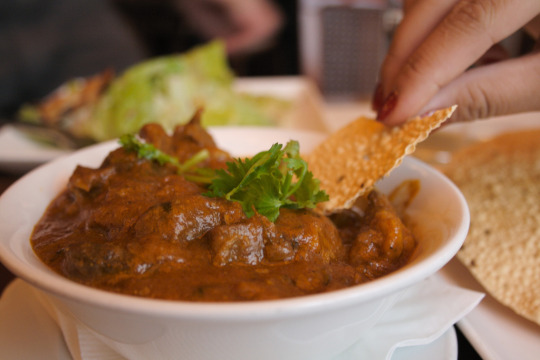
Rogan josh is an aromatic curried meat dish originating from Kashmir. It is made with red meat—traditionally mutton—and colored and flavored primarily by alkanet flower (or root) and Kashmiri chilies. It is one of the signature recipes of Kashmiri cuisine.
A number of origins/meanings of the name have been suggested, such as "stewed in ghee" or "red meat/red juice."
Its characteristic deep red color traditionally comes from dried flowers or root of Alkanna tinctoria (ratan jot) and from liberal amounts of dried, deseeded Kashmiri chilies (lal mirch).
Many modern interpretations of this dish add tomatoes to the sauce. This is especially common with ready-made pour-over cooking sauces to the point that Rogan josh is often described in the modern day as a tomato-based dish.
GORKHALI LAMB

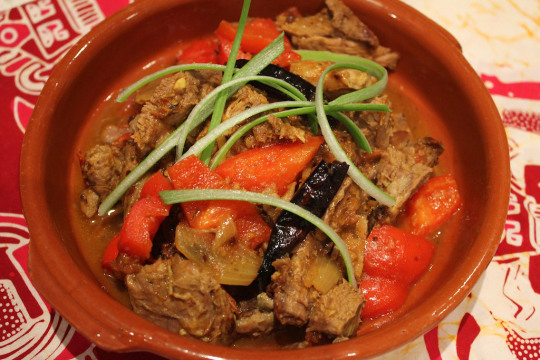
The word Gorkhali (गोर्खाली) is historically synonymous with "Nepali," so Gorkhali lamb could also be called Nepali lamb. The name change, from Gorkhali to Nepali, occurred in the 1930s.
(In the modern day, Gorkha is usually used to refer specifically to military units in the British or Indian army that were made up of men from the North Indian/Nepal region. Starting in 1816 the British East India Company frequently recruited these men as mercenaries, and over time the Gorkhas became very distinguished as exceptional soldiers.)
I couldn't find much about Gorkhali lamb aside from recipes, most of which just echoed the same information, and many of them didn't seem to come from very authentic sources.
From what I've been able to piece together, you make Gorkhali lamb by marinating lamb meat (usually meat on the bone) and cooking it over a charcoal grill. Once it's done, you coat the grilled lamb with a sauce made with chilies and tomatoes, and serve with rice or roti.
I'm not an expert, but it seems like Gorkhali lamb isn't a stew or a curry, it's a sort of marinated, grilled lamb with a sauce. If someone knows more about Gorkhali lamb, please let me know!
Like the Rogan Josh, the addition of tomatoes is a modern invention.
THUKPA
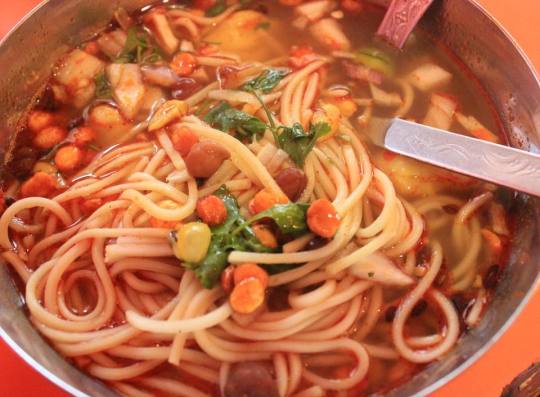
Thukpa is the Tibetan word for any soup or stew with noodles. Thukpa can be prepared in both vegetarian and non-vegetarian variations; the most popular non-vegetarian variation includes chicken, but it is sometimes made with mutton as well.
The Nepalese version of Thukpa is predominant vegetarian, and has a spicier flavor. The protein ingredients are replaced with vegetarian alternatives such as various types of bean.
However, non-vegetarian thukpa is also enjoyed in Nepal, and egg thukpa is probably the second most popular type.
Thukpa is made like most other noodle soups. Some modern recipes include tomatoes in the soup paste, most likely a modern addition.
INDIAN MUTTON CURRIES
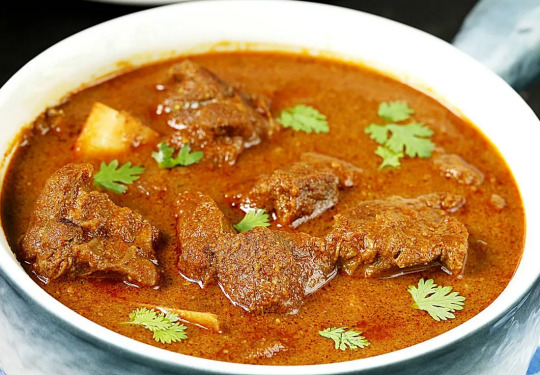
There's many different variations of mutton curry (Kosha mangsho, Mansa kasa, Tapelu, Rezala etc.) throughout the entire Indian subcontinent. Some recipes include tomato, some don't, and as with everything else in this post, the tomatos are a modern addition.
NEPALI MUTTON CURRY
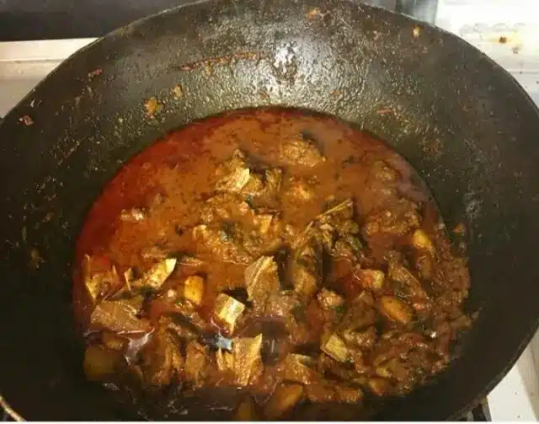
As I said before, mutton is incredibly popular in Nepal. It's reserved for special occasions and celebrations, like Dashain, Nepal's biggest festival. There are many different types of stew and curry in Nepal that feature mutton, and mutton is a popular meat to use in momos or fried rice as well.
SO WHAT IS KABRU'S GOAT STEW?
Unfortunately we still don't have enough information to give a definitive answer.
However, I would say that thukpa and Gorkhali lamb can both be ruled out, since noodles are the core of thukpa and Kabru doesn't mention that his stew is missing noodles. Meanwhile Gorkhali lamb doesn't seem to be a proper stew.
So then what we have left is Rogan josh, and Indian or Nepali mutton curries. Based on all the little tidbits we know, I'd be inclined to assume Kabru's stew is one of these Nepali curries, since they are so iconic of Nepali cuisine and are a big part of the local culture, and that seems to match what Kui tells us in the manga - that this food is a cherished childhood memory.
I've sprinkled some links throughout this post, but you can read more about Nepali mutton curry, and other Nepali food at all of these sites:
https://nepalicooking.tripod.com/lamb.htm
https://www.buzzfeed.com/anupkaphle/here-we-goat-again
https://www.buzzfeed.com/anupkaphle/keep-calm-and-curry-on
https://www.foodpleasureandhealth.com/nepali-style-goat-pakku/
MUSHROOM POSTSCRIPT: I have seen some people get confused by the goat stew page in the manga. They think that when Kabru says "my mother used to make this stew for me" he is talking about Milsiril, the elven woman who took care of him after his birth mother was killed.
Though we do not know 100% for certain, I think this is an objectively incorrect reading of the text. I may make a more comprehensive post about this another time, but:

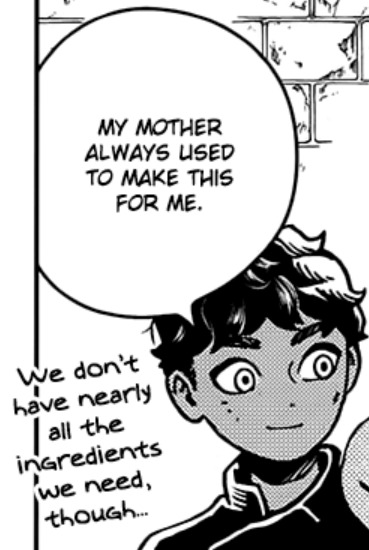

Kabru says he ate this stew as a child, that he hasn't had it in a long time, and that he's looking forward to having it again. He says he is relying on childhood memories in order to make the stew.
If this stew is something Milsiril made for him, why did she stop making it? Why hasn't Kabru had it in a long time? Was there a goat blight for the last 10 years? Did she stop making it to punish Kabru for wanting to leave her? This seems like important information Kui would have told us.
The much more logical assumption is that Kabru's birth mother, who died when he was 7, is the one that made lamb stew, and that's why Kabru hasn't had it in a long time, struggles to remember how to make it, and also why he's so excited to eat it.
This is in direct contrast with the elf fruit cake that Milsiril forced Kabru to eat as a child. Kabru's birth mother made him something he loves, that he is eager to eat again, while Milsiril forced him to eat elf cake so often that it has become his most disliked food.
Kabru and Ryoko Kui never refer to Milsiril as Kabru's mother, the phrase “foster parent” (養母 or 育ての親が, lit. meaning “parent who raised me” in contrast with a birth/blood parent) is used instead in both the manga itself and in the World Guide.
There are several other things like this (how Kabru talks about Milsiril) which I think makes it clear that Kabru probably doesn't call Milsiril mother willingly, and that he goes out of his way to put distance between her and himself. He doesn't hate her, but he doesn't want her to be a part of his life.
Milsiril is a wealthy noble in a society where women are equal to men. It's unlikely that she personally does much cooking, and even if she does cook as a hobby, it's unlikely that Kabru watched her butcher a goat - servants or the butcher would prepare the meat for her.
Milsiril is a fussy eater, and hates most foods. Goat tends to have a strong flavor and is sometimes gamey. I don't think she'd eat goat... Meanwhile, as I stated previously, goat is a delicacy in Nepal, so it would make perfect sense for goat to be a special treat Kabru grew up eating.
Yes, Milsiril sometimes does things she doesn't want to do because Kabru asks... But both examples we have of this, she tries to turn it into a punishment. She explicitly says she's training Kabru so that he'll give up, not because she wants him to get strong and succeed. She wants him to fail. She takes him to her family reunion to prove to Kabru that it's unpleasant, so he won't want to go again. Both times this tactic doesn't work, but she clearly states that this is her intent.
I could go on about this for hours, but this post is really about goat stew!!! But just wanted to throw that in there in case anybody is confused about who exactly cooked goat stew for Kabru.
As I said, there's always the possibility that I'm wrong, but I think the evidence is pretty overwhelming that when Kabru says "my mother cooked this for me" he isn't talking about Milsiril.
#dungeon meshi#delicious in dungeon#kabru#dunmeshi#talking mushroom#dungeon meshi research#kabru of utaya#kabru dungeon meshi#analysis#The Essay#Dungeon Meshi Research
37 notes
·
View notes
Text
One Pot Rasam Rice in Instant Pot
One Pot Instant Pot Rasam Rice.Cozy Comfort in a Bowl!Nothing beats the warmth and satisfaction of a bowl of rasam rice, especially when it’s made in the Instant Pot! This **one-pot rasam rice** is my go-to for comfort food, combining tangy, spicy rasam flavors with soft, fluffy rice for the ultimate meal. Whether you’re enjoying it on its own or pairing it with roasted veggies, this dish is a…
#Comfort food#cozy rice dish#easy rasam rice#gluten-free rasam rice#Indian comfort food#Indian rice recipes#Instant Pot Rasam Rice#instant pot rice recipes#one pot rasam rice#one pot rice recipes#rasam and rice#rasam rice Instant Pot#rasam rice recipe#rasam rice with roasted potatoes#rice in pressure cooker#South Indian rice dish#spicy rice recipe#Tamarind rice#tangy rice dish#vegan rasam rice
0 notes
Text
In Israel, you’ll find a patchwork of different communities. Most Israeli Jews originate from Europe, North Africa and the Middle East, but some come from other regions, such as India.
According to the Indian Embassy in Tel Aviv, there are about 85,000 Jews of Indian origin in Israel — so Indian Jews make up just 1.2% of Israel’s Jewish population. This small community is divided into four groups: the Bene Israel from Maharashtra, the Cochin Jews from Kerala, the Baghdadi Jews from Kolkata, and the Bnei Menache from Mizoram and Manipur.
Although I grew up in the U.S., my mother’s family is from the Cochin Jewish community in Israel. I wanted to find out more about how this community is preserving our unique Jewish traditions from the South of India.
Many of these traditions are at a risk of dying out. For example, the language of the Cochin Jewish community is called Judeo-Malayalam. Today, this dialect has only a few dozen native speakers left (you can hear it spoken in this video).
According to legend, the first Jews arrived in Cochin during the time of King Solomon. The oldest physical evidence of their presence is a set of engraved copper plates dating from around 379-1000 CE, which were given to community leader Joseph Rabban by the Chera Perumal dynasty ruler of Kerala.
Jewish sailors originally arrived in Kodungallur (Cranganore), an ancient port city known as Shingly by Jews, before shifting to Cochin following a flood in 1341. These Jews became known as the Malabari Jewish community. After the expulsion of Jews from Spain in 1492, a group of Sephardic Jews also came to Cochin, and became known as the Paradesi (Foreign) Jews. The Malabari and Paradesi Jews historically lived separately and maintained their own traditions, although in modern times this division has become less important.
Today, the vast majority of Cochin Jews live in Israel. I spoke with several community members to learn about current projects in Israel to preserve Cochini Jewish culture.
Hadar Nehemya, a jazz musician and performer, runs a food delivery service sharing traditional Cochin Jewish recipes. Hadar learned the art of cooking from her mother, who learned it from her paternal grandmother.
Cooking her dishes from scratch and selling them at markets and for delivery, Hadar’s goal is to introduce Cochini cooking into the mainstream of Israeli culture. “Many Israelis don’t know much about Cochin Jewish culture. Maybe they met a Cochini person in the army,” she said. “But Indian food is popular in Israel, because Israelis love to visit India after they finish their army service.”
Cochin Jewish cuisine is similar to other types of South Indian cuisine, but also has influences from Iberian and Middle Eastern cooking. One example is pastel, pastries with a spicy filling that are similar to empanadas. Other staples include fish and egg curries, chicken stew, black-eyed pea stew, dosa (thin rice pancakes) and dishes cooked with coconut and mango.
Hadar’s favorite dishes to cook are idli and sambar, which are often eaten together. Idli is a type of savory rice cake, while sambar is a spiced lentil stew. Although Hadar says it’s difficult to maintain an Indian food business from an economic perspective, she’s passionate about cooking and enjoys creating homemade dishes with the right balance of spices.
Along with cooking, music is also important in Cochini culture. In most religious Jewish communities, women aren’t permitted to sing in front of men who aren’t their immediate relatives. However, this prohibition was not part of the Cochini tradition.
In the Cochin Jewish community, women have sung in Hebrew and Judeo-Malayalam for centuries. Piyyutim (liturgical poems) were sung in the synagogue or at people’s homes during holidays. Judeo-Malayalam folk songs were sung at weddings and special occasions, and the lyrics of these songs were recorded in notebooks to hand down to future generations. Later, many women also learned Zionist songs in preparation for moving to Israel. I have memories of my own grandmother singing these songs at home.
In recent years, audio recordings have been produced of Cochini songs, including a collection called “Mizmorim” (Psalms) featuring Hadar’s grandmother, Yekara Nehemya. Hadar then created her own version of one of the songs, “Yonati Ziv.”
Today, community leader Tova Aharon-Kastiel has organized a choir which meets once or twice a month at different locations. In the choir, Cochini and non-Cochini women, mostly aged 65-85, sing songs in Hebrew and Judeo-Malayalam. The older generation is eager for the younger generation to get involved, but since most younger Cochin Jews have a mixed background and are assimilated into mainstream Israeli culture, this is sometimes proving a challenge.
Still, many young Cochin Jews are eager to connect with their roots. The community maintains several Facebook groups, including one specifically geared towards the younger generation. The group description reads: “If you are a young Cochini, you surely know (at least partially) the wonderful heritage of our forefathers and mothers… the sad truth is that this heritage is currently on its way to pass from the world.”
Shlomo Gadot is the CEO of Inuitive, a semiconductor company, and is actively involved with Cochini community projects. His nephew, Ori, runs the Facebook group for the younger generation. Shlomo says events are regularly held at the Indian Embassy in Tel Aviv for young Cochinis. “Normally the embassy gives them their office in Tel Aviv, and they invite the young Cochini people to come there and do a trivia contest,” he said. “They do it twice a year, once at Hanukkah and once at Passover.”
According to Shlomo, the embassy also has initiatives to create connections between Indian and Israeli tech companies. “Sometimes they invite people to the ambassador’s house or office to see how they can create connections between Israeli and Indian companies,” he said. “They also have a program to bring young people to India to help them get to know India better.”
Anil Abraham is one of the few Cochin Jews with recent memories of life in India. Born in Jerusalem, his family returned to India when he was 8 years old, and he lived there until age 35 before migrating back to Israel. He says he found growing up Jewish in India difficult, but rewarding. “It was very difficult to move there from Israel and learn Malayalam,” he said. “But it was amazing to be part of the community and enjoy Cochini food prepared from scratch. We used to attend prayers in the Paradesi Synagogue, because right now there are fewer than 20 Jews in Kerala.”
Today, Anil runs tours of Kerala for the Cochin Jewish community and others. “The kids travel with their parents and grandparents to India,” he said. “That’s how our traditions are passed down.”
16 notes
·
View notes